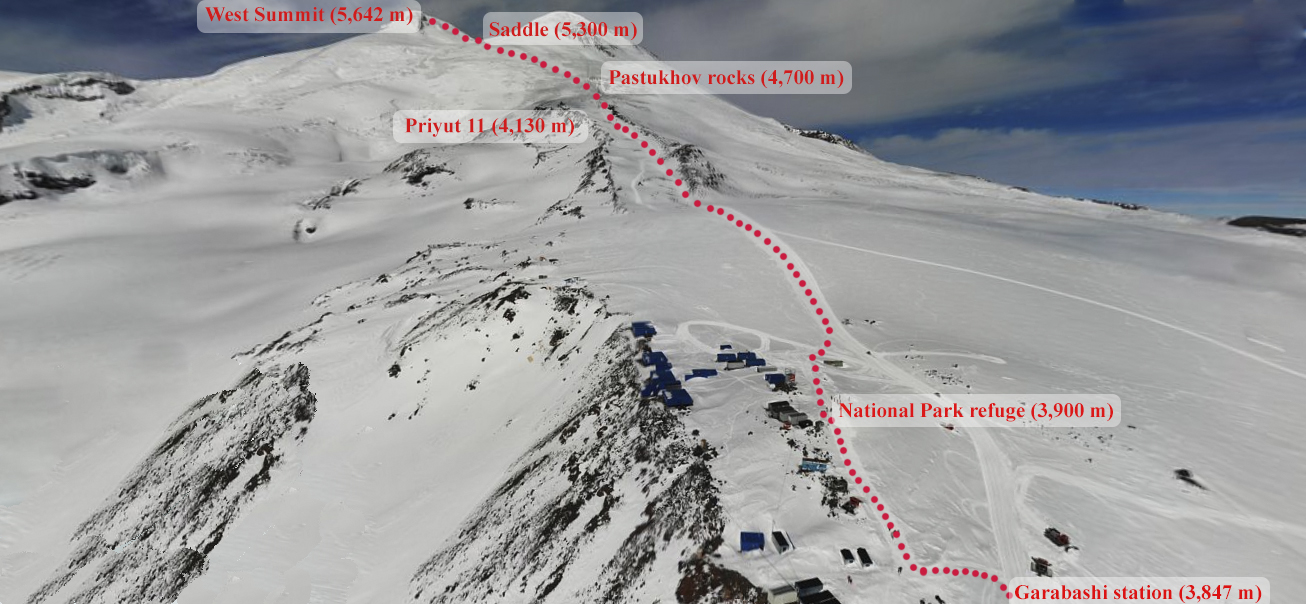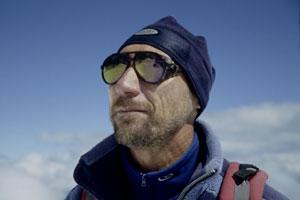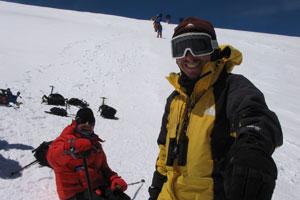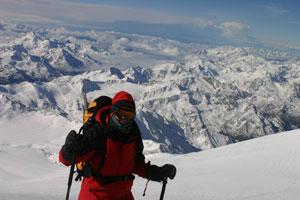Need to Know - Elbrus Climbing
Elbrus Climbing
Please read this section in conjunction with Go Russia General Info on Adventure Tours, FAQ Adventure Trips and view a suggested complete First-Aid Kit Checklist for your trip. Please contact us to obtain information on the medications available from your guide on site. Please also note to guarantee professional service level and first-hand experience we have personally inspected the area and a member of our staff participated on a Elbrus climbing tour.
SECURITY
CLIMBING CONDITIONS
PERSONAL SAFETY
HEALTH ISSUES
SPECIAL EQUIPMENT REQUIRED
ACCOMMODATION
TRAVEL INSURANCE
GUIDES PROFILES
Elbrus being one of the seven summits is a very popular mountain and attracts different climbers from all over the world. To the best of our knowledge no foreign tourists climbing the mountain have been a victim of terrorist attacks in that particular region.
Elbrus is a volcanic massif to the north of the Caucasus Main Ridge. The best time for climbing Elbrus is from May through to August, with the best month normally being July. Normally the ascent begins from the Baksan Valley and is led on the south slope of Mount Elbrus. The standard route we use: Garabashi station – Pastukhov rocks – saddle – West summit does not require any advanced mountaineering experience and it is generally accepted that Mt. Elbrus climb on the normal route is non-technical and suitable for beginners. There are other routes to the summit which are considered more technically challenging.

For guiding this climb we always use experienced top-skilled Russian mountaineers. Systematic acclimatisation is essential prior to making the ascent. The climb itself may take between 6-10 hours; the descent another 4-6 hours. The main obstacles are high altitude, fog, wind and the cold. This is a fine ascent which is more a test of stamina rather than a technical task, although high altitude and unpredictable weather make for a challenging and adventurous trip. Although the climb is not technically difficult but requires crampons and an ice axe. It is a very achievable challenge which requires proper cold weather clothing and basic mountaineering skills which you can develop during the trip.
And our guides explain use of the ice axe on your free acclimatisation day on the Bochki camp or any other day depending on weather conditions and other factors on a trip. Any necessary climbing skills will be taught during this trip so mountaineering experience is not required. IMPORTANT: climbers are expected to be in good physical condition. Your safety is very important to us. As stated in our booking conditions your booking is accepted on the understanding that (1) you realise and accept the risks and hazards potentially involved in adventure holidays and that (2) you are mentally and physically capable of undertaking your chosen trip. You must tell us if you have an existing medical condition or disability that might affect your travel arrangements before your booking. If you suffer from hypertension, diabetes, cardiovascular disease, brain disease - you will not be allowed to participate in this tour.
During the tour you must fully abide by the authority and decisions of our employees, tour leaders, and suppliers. The decision of these people as to the conduct, itinerary and objectives of the tour is final and if, in their opinion your behavior or physical condition is detrimental to the safety, welfare and well-being of the group as a whole (which are the paramount considerations), or they consider that your general well-being will be put at risk by continuing with the trip, you may be asked to leave the tour without the right to any refund for unused services.
Upon your arrival in Elbrus area you will have a safety briefing at your hotel with your guide and other group members. The guide will explain your day-to-day itinerary, time schedule, how to prepare for the ascent, safety rules and also check your personal equipment. At this stage you will be required to sign the paperwork that you have read and understood “The Safety Rules” which you must follow during your tour and you consider yourself to be in a good physical condition and capable of taking part in the ascent. Download “The Safety Rules Declaration”. Lack of oxygen at high altitudes (over 2500m.) affects most people to some extent. The effect may be mild or severe and occurs because the air pressure is reduced and the heart and lungs must work harder to oxygenate the body. While mild AMS (Acute Mountain Sickness) does not interfere with normal activity, the persistent and worsening symptoms can lead to the severe AMS and even to two very serious conditions such as High Altitude Pulmonary Edema and Cerebral Edema which could be fatal. Unfortunately youth, good fitness and previous experience at high elevations do not necessarily mean that you will be less likely to have problems with altitude.
The symptoms of AMS include: Headache, Dizziness and nausea , Loss of appetite, Disturbed sleep, Shortness of breath. The best medicine is prevention and there are some things that climbers can do to to minimize their risks of illness and improve their performance:
The key to clothing is the layering system. Layers can be added or discarded with temperature fluctuations. The first layer is a form of synthetic underwear that draws moisture away from the skin and dries quickly. This is followed by two or more insulating layers, also preferably of synthetic pile and a windproof outer layer. This system applies not only to the torso but also to extremities.
You can rent locally some of the necessary climbing equipment (prices are in EUR per day). You need equipment for 4-5 days:
Note: Please consult us about climbing gear and renting possibilities. Please note that Go Russia does not guarantee rental prices! While we aim to provide the most updated and accurate information on all services including rental possibilities it is not always possible due to various reasons. All hire companies are privately owned and operate their business independently. We do apologize for this, but this is not what we can control or influence. We generally use local 3* hotels. In the Elbrus area we stay in one of the best local hotels in twin rooms with showers (en-suite).
On the way up to the summit of Elbrus it is easier to stay overnight in the huts. So we use the well-known Refuge of Elbrus National Park situated at the end of the last chair lift. The camp is placed on Garabashi hill on the slopes of Elbrus at approx. 3,900 m. These are small houses with rooms for 4 people. There is also a canteen with kitchen facilities in the separate hut. There are no showers, toilets are located in a separate hut. It is a condition of joining our climbing tours that you have adequate travel insurance for the complete duration of your trip to cover at least medical expenses, injury, death and cost of repatriation. For all our customers traveling to Elbrus we will arrange insurance through one of the leading Russian providers covering medical expenses for the sum up to USD50,000, as the US insurers are reluctant to deal with the area due to the Department of State advice. The cost of this insurance is included in the package price of the tour. Please ensure that any travel insurance arranged through the Company is what you require and you should arrange supplementary insurance if need to be. Please view the insurance policy terms and conditions.
We include in the tour price insurance policies for all travellers not older than 65 years. If you are 65 years and older there will be a surcharge of $70.
Insurance cover
Please note your insurance cover is valid only for the dates you are in Elbrus area. Extreme sports covered: mountain climbing, mountaineering.
SECURITY
CLIMBING CONDITIONS
PERSONAL SAFETY
HEALTH ISSUES
SPECIAL EQUIPMENT REQUIRED
ACCOMMODATION
TRAVEL INSURANCE
GUIDES PROFILES
SECURITY
Please be aware that US Department of State advises against all travel to the Elbrus area. For more details please visit: https://travel.state.govElbrus being one of the seven summits is a very popular mountain and attracts different climbers from all over the world. To the best of our knowledge no foreign tourists climbing the mountain have been a victim of terrorist attacks in that particular region.
Elbrus is a volcanic massif to the north of the Caucasus Main Ridge. The best time for climbing Elbrus is from May through to August, with the best month normally being July. Normally the ascent begins from the Baksan Valley and is led on the south slope of Mount Elbrus. The standard route we use: Garabashi station – Pastukhov rocks – saddle – West summit does not require any advanced mountaineering experience and it is generally accepted that Mt. Elbrus climb on the normal route is non-technical and suitable for beginners. There are other routes to the summit which are considered more technically challenging.

For guiding this climb we always use experienced top-skilled Russian mountaineers. Systematic acclimatisation is essential prior to making the ascent. The climb itself may take between 6-10 hours; the descent another 4-6 hours. The main obstacles are high altitude, fog, wind and the cold. This is a fine ascent which is more a test of stamina rather than a technical task, although high altitude and unpredictable weather make for a challenging and adventurous trip. Although the climb is not technically difficult but requires crampons and an ice axe. It is a very achievable challenge which requires proper cold weather clothing and basic mountaineering skills which you can develop during the trip.
And our guides explain use of the ice axe on your free acclimatisation day on the Bochki camp or any other day depending on weather conditions and other factors on a trip. Any necessary climbing skills will be taught during this trip so mountaineering experience is not required. IMPORTANT: climbers are expected to be in good physical condition. Your safety is very important to us. As stated in our booking conditions your booking is accepted on the understanding that (1) you realise and accept the risks and hazards potentially involved in adventure holidays and that (2) you are mentally and physically capable of undertaking your chosen trip. You must tell us if you have an existing medical condition or disability that might affect your travel arrangements before your booking. If you suffer from hypertension, diabetes, cardiovascular disease, brain disease - you will not be allowed to participate in this tour.
During the tour you must fully abide by the authority and decisions of our employees, tour leaders, and suppliers. The decision of these people as to the conduct, itinerary and objectives of the tour is final and if, in their opinion your behavior or physical condition is detrimental to the safety, welfare and well-being of the group as a whole (which are the paramount considerations), or they consider that your general well-being will be put at risk by continuing with the trip, you may be asked to leave the tour without the right to any refund for unused services.
Upon your arrival in Elbrus area you will have a safety briefing at your hotel with your guide and other group members. The guide will explain your day-to-day itinerary, time schedule, how to prepare for the ascent, safety rules and also check your personal equipment. At this stage you will be required to sign the paperwork that you have read and understood “The Safety Rules” which you must follow during your tour and you consider yourself to be in a good physical condition and capable of taking part in the ascent. Download “The Safety Rules Declaration”. Lack of oxygen at high altitudes (over 2500m.) affects most people to some extent. The effect may be mild or severe and occurs because the air pressure is reduced and the heart and lungs must work harder to oxygenate the body. While mild AMS (Acute Mountain Sickness) does not interfere with normal activity, the persistent and worsening symptoms can lead to the severe AMS and even to two very serious conditions such as High Altitude Pulmonary Edema and Cerebral Edema which could be fatal. Unfortunately youth, good fitness and previous experience at high elevations do not necessarily mean that you will be less likely to have problems with altitude.
The symptoms of AMS include: Headache, Dizziness and nausea , Loss of appetite, Disturbed sleep, Shortness of breath. The best medicine is prevention and there are some things that climbers can do to to minimize their risks of illness and improve their performance:
- The mountaineer’s dictum “Climb high, sleep low” is the best method to prevent AMS;
- Stay properly hydrated (drink at least 4-6 liters of liquids per day). Urine output schould be copious and clear to pale yellow;
- Eat a high calorie diet while at altitude;
- Take it easy and don’t push yourself when you get at altitude;- A slow and steady pace will carry you much higher and easier;
- Avoid tobacco, alcohol and any depressant drugs.
If the symptoms increse go down! These are guidelines only! For more detailed and professional information regarding the AMS please refer to the following links: www.traveldoctor.co.uk, www.thebmc.co.uk, www.ismmed.org
Climbing equipment- Double plastic boots
- Crampons: step-ins or strap-on (10-12 point), check that the boots fit beforehand. Point protectors are also useful for storage and adjusting tool
- Ice axe: general mountaineering – normally 65cm. – preferable to have rubber end protectors
- Climbing harness with carabiners
- Trekking poles
- Gaiters
The key to clothing is the layering system. Layers can be added or discarded with temperature fluctuations. The first layer is a form of synthetic underwear that draws moisture away from the skin and dries quickly. This is followed by two or more insulating layers, also preferably of synthetic pile and a windproof outer layer. This system applies not only to the torso but also to extremities.
- Hiking boots
- Socks: liners - medium weight and heavy, at least few pairs of each
- Lightweight long underwear, top and bottom
- “Expedition-weight” long underwear, top and bottom
- Pile jacket
- Pile trousers
- Windbreaker, waterproof/breathable
- Wind pants, waterproof/breathable
- Synthetic or down parka with hood. If you cannot provide this you must be sure of providing an extra warm fleece to compensate and a windproof outer jacket. This is seldom worn whilst climbing but most appreciated during meals, in camp and in pre-dawn hours of cold summit days
- Balaclava or something to cover the face like a neck warmer or even a scarf
- Sunhat, wool or fleece hat (warm with ear flaps)
- Mitts with gore-Tex or waterproof shells or one pair of very warm gloves with inners
- Rucksack (min. 65 liters)
- Day pack (around 35-40 liters) used for valley hikes and summit mornings
- Sleeping bag 3 seasons (rated to -10 - -5 degrees C). The huts are relatively warm
- Water bottles - 2 x 1 liters capacity. (Platypus, Nalgene bottles or thermos)
- Sunscreen and lip balm
- Headlamp
- Sunglasses (100% UV)
- Goggles - optional (useful for contact lens wearers or in bad weather)
- Toiletries
- First-aid kit (please refer to our “First-aid checklist”)
- Camera and memory cards (film)
You can rent locally some of the necessary climbing equipment (prices are in EUR per day). You need equipment for 4-5 days:
- Plastic climbing boots - 8-10 EURO (max size - 47, min size - 35)
- Crampons - 5 EURO
- Ice axe - 5 EURO
- Poles - 5 EURO
- Carabiner - 1,5-2 EURO
- Harness - 2 EURO
- A piece of rope for self belay - 1 EURO
- Sleeping bag - 7 EURO
- Down mittens - 4 EURO
- Down jacket - 10 EURO
- Gore-tex jacket - 7 EURO
- Gore-tex trousers - 4 EURO
- Gaitors - 3,5 EURO
- Wind proof mask - 5 EURO
- Head torch - 2 EURO
- Sun glasses - 4 EURO
- Thermos - 2 EURO
Note: Please consult us about climbing gear and renting possibilities. Please note that Go Russia does not guarantee rental prices! While we aim to provide the most updated and accurate information on all services including rental possibilities it is not always possible due to various reasons. All hire companies are privately owned and operate their business independently. We do apologize for this, but this is not what we can control or influence. We generally use local 3* hotels. In the Elbrus area we stay in one of the best local hotels in twin rooms with showers (en-suite).
On the way up to the summit of Elbrus it is easier to stay overnight in the huts. So we use the well-known Refuge of Elbrus National Park situated at the end of the last chair lift. The camp is placed on Garabashi hill on the slopes of Elbrus at approx. 3,900 m. These are small houses with rooms for 4 people. There is also a canteen with kitchen facilities in the separate hut. There are no showers, toilets are located in a separate hut. It is a condition of joining our climbing tours that you have adequate travel insurance for the complete duration of your trip to cover at least medical expenses, injury, death and cost of repatriation. For all our customers traveling to Elbrus we will arrange insurance through one of the leading Russian providers covering medical expenses for the sum up to USD50,000, as the US insurers are reluctant to deal with the area due to the Department of State advice. The cost of this insurance is included in the package price of the tour. Please ensure that any travel insurance arranged through the Company is what you require and you should arrange supplementary insurance if need to be. Please view the insurance policy terms and conditions.
We include in the tour price insurance policies for all travellers not older than 65 years. If you are 65 years and older there will be a surcharge of $70.
Insurance cover
Please note your insurance cover is valid only for the dates you are in Elbrus area. Extreme sports covered: mountain climbing, mountaineering.
| Cover | Sum insured per person |
|---|---|
| Doctor call | 50,000 $ |
| Outpatient treatment | 50,000 $ |
| Hospitalization | 50,000 $ |
| Emergency dentistry | 250 $ |
| Transportation to doctor or hospital including use of helicopter | 10,000 $ |
| Phone calls to the service centre | 30 $ |
| Transportation of remains / repatriation | 50,000 $ |
| Exacerbation of chronic diseases | 3,000 $ |
| Dangerous fevers, including COVID-19 | 50,000 $ |
| Loss and theft of documents | 50,000 $ |
| Legal aid | 50,000 $ |
| Medical transportation and other expenses per person | |
| Search and rescue activities including helicopter | 5,000 $ |
| Helicopter evacuation | 10,000 $ |
| Return home costs | 50,000 $ |
| Early return home costs as per p. 10.3.4 of the insurance rules | 50,000 $ |
| Third person visit | 50,000 $ |
| Scheduled flight delay of more than 4 hours | per hour no more than 50 $ |
GUIDES PROFILES
 |
Name: Pavel Occupation: Qualified Teacher of the Russian Federation Education: MSc Achievements: Mountaineer, referee, international rank C in skiing Home: Piatigorsk Pavel’s interest in mountaineering started 27 years ago and since then he’s been successfully combining his full-time teaching job with his lifelong passion for mountains. He’s been leading expeditions to Elbrus since 1984 and also working as a ski instructor on Elbrus since 1988. |
|
 |
Name: Igor Occupation: climbing guide and skiing instructor, specialist in industrial mountaineering Education: MSc Achievements: candidate for Master of Mountaineering, world class rock and ice climber, winner of numerous Ukrainian Rock and Ice Climbing Championships Home: Ukraine Igor has been attracted to this adventurous profession from the age of 28. He has devoted his spare time to conquering mountains in different seasons and - as often happens – his hobby became a profession. Guide on Elbrus since 1989 and ski instructor since 2002. |
|
 |
Name: Elena Occupation: climbing guide, tour leader, manager Education: MSc Achievements: candidate for Master of Mountaineering, 10 ascents of peaks over 7,000m (former USSR) Home: St. Petersburg She has got it all! Impressive achievements and an exciting life! Elena’s experience in mountaineering is vast – 27 years of climbing, 17 years as an instructor, more that 20 years leading groups (including schools) on Mt Elbrus. |